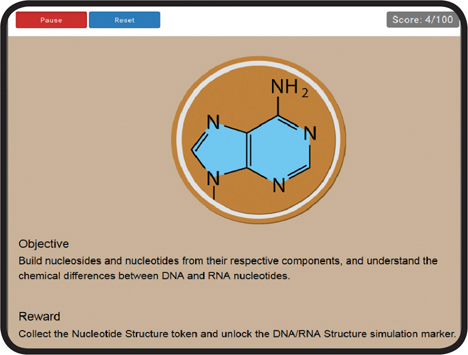MEDIA
Simulations
One of our central goals in tackling the revision of this textbook was to provide special resources to engage students (and educators) in molecular biology. New to the second edition are simulations that cover core molecular biology concepts and techniques. Created using the art from the text, the simulations reinforce students’ understanding by allowing them to interact with the structures and processes they have encountered. A gamelike format guides students through the simulations, unlocking them in order, and multiple-
xxvi
Nucleotide Structure (Chapter 3)
DNA/RNA Structure (Chapter 6)
PCR (Chapter 7)
Sanger Sequencing (Chapter 7)
CRISPR (Chapters 7 and 19)
DNA Replication (Chapter 11)
DNA Polymerase (Chapter 11)
Mutation and Repair (Chapter 12)
Transcription (Chapter 15)
mRNA Processing (Chapter 16)
Translation (Chapter 18)

Nature Articles with Assessment
These articles engage students in reading about primary research and encourage critical thinking. Specifically selected for both alignment with the text coverage and exploration of identified difficult topics, the Nature articles include assessment questions that can be automatically graded. Also included are open-
The simulations and Nature articles for Molecular Biology: Principles and Practice are available in our LaunchPad system, along with many additional resources.

This dynamic, fully integrated learning environment brings together all of our teaching and learning resources in one place. It also contains the fully interactive e-
New Clicker Questions allow instructors to integrate active learning in the classroom and to assess students’ understanding of key concepts during lectures.
Updated Test Bank contains at least 40 multiple-
 allows students to test their comprehension of the chapter concepts. The system adapts to students’ individual level of preparedness by giving them questions at varying levels of difficulty, depending on whether they answer a question without help, or they need help but eventually get the question right, or they are unable to answer the question. Links to the appropriate e-
allows students to test their comprehension of the chapter concepts. The system adapts to students’ individual level of preparedness by giving them questions at varying levels of difficulty, depending on whether they answer a question without help, or they need help but eventually get the question right, or they are unable to answer the question. Links to the appropriate e-
Key Term Flashcards allow students to review the definitions of all the glossary terms and quiz themselves.
Textbook Images and Tables are offered as high-
xxvii